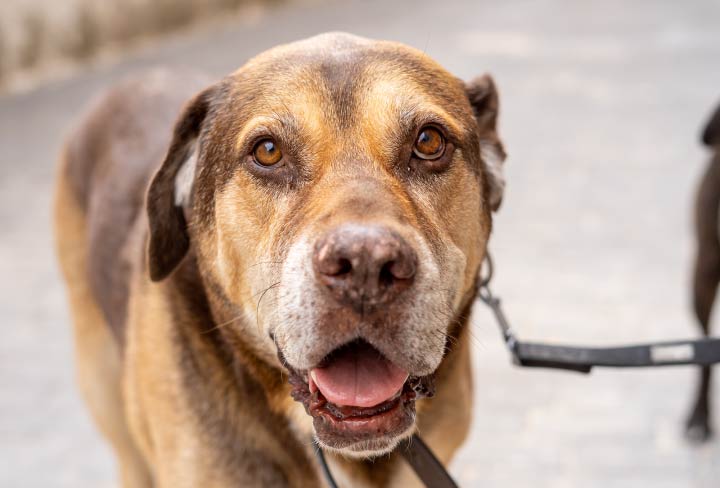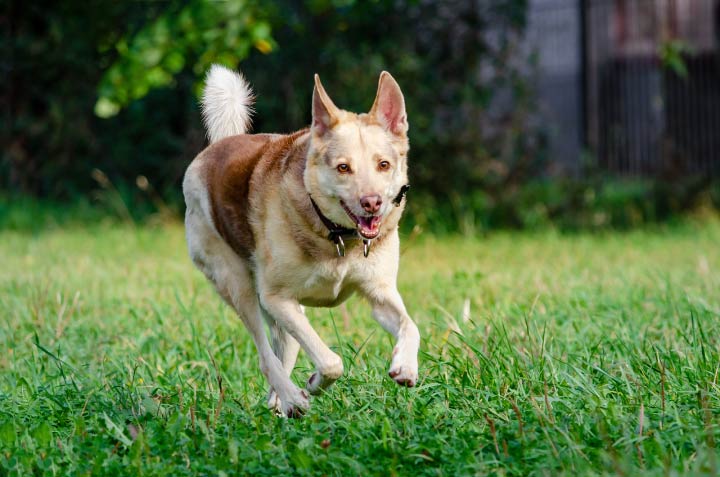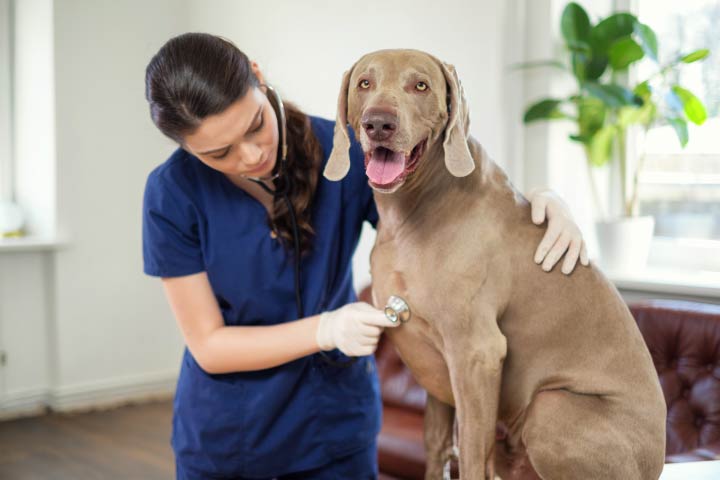
“He’s having a hard time getting up the stairs.”
“She’s just not eating quite like she used to.”
“Sometimes she just seems confused, like she’s not sure where she is.”
“He just seems like he’s slowing down a bit.”
Do any of these statements sound familiar?
If they do, it’s probably because you’ve said them to a friend, a family member, or your vet about your senior dog.
Our senior pups have very unique needs. In this article we’re going to discuss what those needs are by first reviewing the changes older dogs go through with their joints, their body systems, and even their minds.
We’re also going to review 3 tips to help your senior pooch keep those olden years as golden as possible.
But first, what actually constitutes a senior dog? How old does a pup have to be to be considered “old”?
What is a Senior Dog?
It may seem like a bit of a silly question, but it’s more complicated than you might think.
We consider most pups to be seniors around the age of seven. Mostly, this is because there are so many dog breeds and especially mixes of breeds, that we need to have some common age for all dogs at which we start monitoring their health more closely.
But in reality, the time at which a dog truly reaches senior citizen status depends on her breed and size, because life expectancy varies quite a lot. A Chihuahua, for example, will reach skeletal maturity by one year, or even a month or two sooner. A Labrador Retriever might be expected to reach maturity later, around 14 or 15 months. A Great Dane however, may not reach full growth and adult status until 2 years.
A Chihuahua can live a pretty long time, rivaling the lifespan of cats. It’s not uncommon to see a Chihuahua living until 17 years of age. A Labrador however, rarely lives past 15. Your Great Dane? Unfortunately, 10 years is considered pretty old for a Dane.
For a Chihuahua, we might consider her to be a true senior around 10. The Lab would be a senior around 7, but the Dane would actually be a senior at about 5 or 6 years.
So generally, the equivalent in human years is about 50. While humans often think of 65 as senior status, this is probably actually too old even for us to just start thinking about senior health. We really should be thinking seriously about our health much earlier, and the same goes for our pups.

Health Conditions Senior Dogs Face
Now we’re going to review some health challenges that senior dogs face, including a little about what causes them and how we recognize signs that these conditions are present.
Those Creaky Old Joints: Arthritis
Arthritis is one of the most common conditions we associate with senior dogs. As dogs get older they “slow down” on walks, can’t use the stairs as well, and have a harder time standing up after a long nap.
According to the American Animal Hospital Association, at least 20% of dogs over one year of age in the United States are affected by osteoarthritis. That’s only 1 in 5 pups. This also means many pups are affected by arthritis much earlier than many folks think.
By the time a dog reaches his senior years, he is almost guaranteed to have some degree of arthritis present, whether it’s visually apparent or not. One 2018 study in Scientific Reports indicates that in North America, 80% of dogs over 8 years of age have evidence of osteoarthritis based on x-rays and exam findings.
Many dogs hide signs of discomfort, either out of instinct to not appear weakened to other dogs, or just out of a desire to please and be happy by continuing to chase the ball and going for long walks. This can be especially true for arthritis, which is often a slowly progressive condition.
So what do you look for? It might be subtle at first, but if your dog looks kind of stiff, having a hard time standing from that resting position, but then seems to be fine once he gets going on that walk, you should be suspicious for arthritis.
If you recall your older dog having either an orthopedic injury, like an ACL tear, or a condition she was born with, like early hip dysplasia, an early start to arthritis should be assumed and it’s a good idea to have discussions and address it earlier.
When Filters Start to Fail: Kidney Disease
The kidneys are responsible for a lot of functions in the body but the greatest is the filtration of toxins and production of urine. It’s also important to remember that the kidneys don’t just dump stuff out in urine. Part of filtration means retaining and recycling important things too.
These filtration components in the kidney degrade over time, which eventually can lead to a reduced ability to concentrate urine (causing pee to be very clear and dilute), loss of protein and certain electrolytes, and build-up of certain toxins in the bloodstream.
According to the Illinois University College of Veterinary Medicine, kidney disease is the 3rd most common cause of death in dogs.
This means that it’s certainly something that affects a lot of our pups. The good news though is that while it does affect many dogs, it tends to progress slowly in most, giving us time to catch it early and make some interventions.
As we’ll discuss just a little later, this is why regular lab work checks are very important for seniors. It’s common to recommend a panel every 6 months once a dog reaches the age of 7. Screening lab work helps us to identify kidney disease as early as possible.
There is often a bigger focus on bloodwork, but urine samples are just as important. In fact, signs of kidney disease often show up first on a urinalysis with a lower urine concentration, even from an early morning pee sample. Some dogs with early kidney disease will also show signs of protein loss into the urine coupled with that lower concentration.
If we see signs like this, it’s recommended to begin intervention at that time. And a good thing too. If we wait for bloodwork values like BUN, creatinine, and phosphorus to become elevated, we already know that at least 65% of kidney function has been lost.
It’s common to address early kidney disease with diet changes which we’ll discuss more in the section on diet. It’s also common to start a pet on blood pressure medication if we document hypertension or see evidence of protein in the urine.

The Thick and Thin of It: Body Condition Changes
As we age, we tend to lose muscle over time and gain fat instead. But while this fat-replacing-muscle process is known to generally occur, it’s hard to predict how this will affect a particular pet’s body condition as he or she ages.
Some dogs, as they gain fat will gain more weight. If this is coupled with bad arthritis and decreased mobility, weight gain can be worse, which in turn places more stress on the joints. This vicious cycle can really affect the quality of life for many older dogs.
But other dogs will do the opposite. As they lose muscle mass, they lose weight, even as some of that muscle is replaced by fat.
The reason this is important is because calorie requirements can be different for different dogs. There is quite a lot of debate about whether senior dogs need less protein to protect against chronic disease, like kidney disease, or more protein to help stave off muscle loss.
We’ll talk more about diet a little later, but understanding your pet’s body condition and muscle condition scores is important to understanding what his needs are and discussing those with your vet.
Here’s how to generally assess your pup’s body condition. Start by looking at the area just behind your pup’s ribs. From the top, there should be a gentle dip inwards from the last rib to the hips. When looking at her from the side, her belly should slope gently upwards from the last rib to the groin. If your dog loses this “Coke bottle” shape, appears very flat from the last rib back and has no belly tuck at all, she is crossing the line to being overweight.
Generally, while you should be able to feel the last couple of ribs, you shouldn’t be able to see them easily. Dogs that are underweight will also have more prominent pelvic hip bones and an almost concave appearance between the last rib and the hips.
We take this info and translate it into what’s called a body condition score. A body condition score consists of assigning a numerical value out of a scale of 1 through 9 with 1 being an extremely thin and emaciated pup to 9 being the most obese. The ideal range is a 4 or 5.
For a chart complete with images and full steps for each numerical score value, see the World Small Animal Veterinary Association Global Nutrition Committee’s body condition score chart
Because muscle loss is so important to monitor in older dogs, there is actually a separate scoring system developed by veterinarians at Tufts University. Essentially, a dog losing muscle has either mild, moderate, or severe muscle loss. See the WSAVA muscle condition score chart as developed by Cummings Veterinary Medical Center at Tufts University, to learn how to recognize if your pup has good muscle condition.
Many folks wrongly assume that a pet has to lose a lot of weight or be very skinny to start losing muscle, but this isn’t true. You actually can have an overweight pet show signs of muscle loss. You can also have a very thin dog that has normal muscling. And as we already talked about, this is so true for seniors.
To understand muscle loss better, make sure to check out this article on assessing muscle condition in pets developed by veterinarians from the Clinical Nutrition Service at Tufts University.
The Old Ticker: Heart Disease
Heart disease in people and dogs is a little bit different. The biggest risk of heart disease in people is related to diets high in cholesterol leading to atherosclerosis plaque build-up in blood vessels, and subsequent heart attack.
But this condition is not generally appreciated in dogs. In dogs, we typically see heart disease secondary to breed or genetic predisposition, and age-related degeneration. The most common type by far is degeneration of the mitral valve on the left side of the heart, especially in smaller breed dogs.
Just like kidney disease, the best way to manage heart disease is to catch it early, and this is something your veterinarian can easily do with a physical exam.
A large majority of dogs with underlying heart disease will have what’s called a heart murmur. When your vet listens to your dog’s heart with a stethoscope as part of a routine exam, a heart murmur can be heard as a “whoosh whoosh” noise instead of the iconic “thump thump”. The “whoosh” is caused by the flow of blood backwards through the valve, when the valve becomes either thickened and stiff or loose from disease and does not fully close.
In dogs, the severity of the murmur does tend to correlate well with the severity of heart disease. With a low grade murmur, your vet may recommend monitoring it, or may recommend staging things early by checking blood pressure and some x-rays of the chest.
If a veterinary cardiologist is available in your area, referral to one may be recommended. An ultrasound of the heart, called an echocardiogram, is the best way to get specific information about how the heart is functioning and whether or not some early medications may be beneficial to slow down disease progression.
When the Mind Starts to Fail: Cognitive Dysfunction
In later stages of aging, we can see dogs, as with people, show changes in mental acuity, alertness, memory, and orientation.
In dogs we call this cognitive dysfunction, which is a generalized term for those changes. In people, older age changes in mental health are categorized more specifically (Alzheimer’s is only one form of dementia recognized in people).
According to The Ohio State University, cognitive dysfunction affects nearly 30% of dogs between 11 and 12 years of age. By 15-16 years, almost 70% of older pups show at least one sign of cognitive dysfunction.
So what are some of those signs? The most commonly reported is a pup who seems to get confused or lost in familiar surroundings. Dogs might appear to wander aimlessly through the backyard or the home, like they don’t know where they’re going, then seem to “get it together” and be fine again.
Dogs can also be seen barking randomly at things that don’t appear to be there, standing in corners or facing walls, and may appear to be restless, especially at night.
Cognitive dysfunction is a diagnosis of exclusion, meaning we need to make sure we rule out other things first. For example, an excessively panting and pacing dog may actually be showing signs of pain that we certainly don’t want to ignore.
But if there appears to be no other explanation for some of these odd behaviors, cognitive dysfunction is quite possible.
Unfortunately, there is no cure for cognitive dysfunction, but there are a couple of strategies that have shown to be of benefit, which we’ll include in our next section.
3 Tips to Help Senior Dogs
There are 3 categories of ways we can work to help our senior dogs not just live longer lives, but better quality lives too.
1. Continue Regular Exercise and Environmental Enrichment
Just because a dog is old doesn’t mean he doesn’t want to go out for walks, play, and have a good time.
While you may not be able to go for that 5 mile run like you used to, make sure to get at least 15-30 minutes of good walking time in a couple of days a week. Keeping up regular exercise helps to maintain muscle tone and strength, maintain a good body condition, and keeps her mind alert.
While some pups may need some medical assistance like we’ll soon talk about, even arthritic dogs should still be able to do some regular exercise. Keeping up muscle tone and limb strength is actually very important so that soft tissues are contributing to keeping your pup upright, and not just those creaky old joints.
It can be beneficial to add other enrichment in the form of new, more interactive toys, and create some new training goals or learning tasks. This can especially be true for dogs showing signs of cognitive dysfunction. Focusing on learning and memory can be very helpful, as proven in prevention and therapy for Alzheimer’s in people.

2. Ensure Diet is Meeting Needs
It’s a common question among pet parents when a pet is starting to get into his older years if an adult diet should now be switched over to a senior diet.
The problem is that there is no legal requirement for senior diets to be formulated a certain way. They are only required to meet the same nutritional standards as an adult diet. This means that diets labeled as “senior” or “mature” can have a lot of variation in how they’re formulated.
It’s far wiser to make dietary adjustments for senior dogs based on the specific needs they have. And for any of the conditions we’ve recently talked about, there are some nutritional recommendations to make.
As an inflammatory condition causing a continuous cycle of tissue damage, antioxidants as well as nutrients with anti-inflammatory properties can be helpful for arthritis.
Common to most diets, Vitamin C and Vitamin E both serve as antioxidants, scavenging free radicals and preventing cell damage throughout the body. The omega-3 fatty acids DHA and EPA have similar functions in addition to having anti-inflammatory properties. Omega-3s can be found in many diets, sometimes labeled as fish oil or salmon oil. But it is best to look for DHA and EPA specifically as they have the most proven benefits.
It can also be common to see glucosamine, chondroitin, and other joint supplement ingredients included with senior or joint health diets and can be helpful to look for them in ingredient lists if your pup is showing those signs of slowing down.
Protein levels and calorie content varies considerably across all diets, even senior foods. A good rule of thumb to follow is that if you’re trying to get your pup to lose weight, aim for a food that is less than 350 kilocalories per cup or can. If you’re having trouble keeping weight on her, aim for over 400.
There is some debate about whether we should feed more protein to senior pets, or less. The simple truth is that we should be feeding at least the same levels of protein to seniors who are maintaining their muscle just fine.
If we’re facing certain conditions like cancer, heart disease, or muscle loss from poor mobility, higher levels of protein are needed. But in pets with kidney disease, especially advanced stages, restricting protein can be very important.
Even more important than restricting protein in pets with kidney disease, is restricting the mineral phosphorus. Kidneys that are failing have a reduced ability to filter and excrete phosphorus, which can lead to high levels in the bloodstream.
Restricting another mineral, sodium, is important for both heart disease patients and kidney disease patients, as both conditions can predispose pets to high blood pressure.
For cognitive dysfunction, according to The Ohio State University, there are several dietary components that have shown benefit in combination for dogs. Omega 3 Fatty Acids to promote cell membrane health, antioxidants like Vitamin C and Vitamin E, additional antioxidants like beta carotene, and L-carnitine to enhance mitochondrial function.
Trying to figure out how to meet these needs with over the counter diets can be really difficult. Very few diets will list the maximum levels at which certain nutrients are included, like protein, phosphorus, and sodium.
This is why veterinarians commonly recommend prescription diets for certain disease conditions, especially kidney disease, where levels of these ingredients are strictly controlled. There are also prescription diets for joint health and mobility, heart disease, diabetes, and even cognitive dysfunction.
Generally, if we’re doing well on a particular diet but we want to target something specific that it doesn’t cover, it can be okay to consider supplementation. For example, if your dog’s diet doesn’t have omega fatty acids supplemented already, you can consider adding a supplement like the clinically tested Joint Health Advanced Formula.
Most commercial diets come formulated with the minimum levels of vitamins, minerals, and other nutrients required. But if your older dog is getting picky or if she’s not eating a balanced food, adding a daily vitamin supplement like Four-In-One can be beneficial.
For some more details on the dietary needs of senior dogs, make sure to check out our article Is There a Best Senior Dog Food?

3. Regular Health Checks
Because helping our senior dogs means knowing what disease conditions their bodies are trying to cope with, it’s necessary to identify those as soon as possible.
For dogs over 7 years of age, it’s common to recommend exams every 6 months, because we know that older pups are at higher risk for developing health complications, and it may not take long for these things to rear their ugly heads.
But if you’re noticing some changes in your senior dog, it’s important not to wait to have her looked at by your vet. Many folks will make incorrect assumptions about what they’re seeing in their old pup, chalk these changes up to old age when in fact there is something more pressing going on and assume that what they’re seeing is irreversible and cannot be treated.
For example, one of my patients came in to see me one morning as an urgent care visit because he was suddenly having a really hard time using his back legs. He was stumbling, falling over, and generally having a pretty tough time.
His family was prepared for the worst, since he was probably just “old” and this was likely just “his time”.
But when I diagnosed him with a back condition that would be treatable with medication, allowing him to regain much of his normal function, his parents were surprised and relieved. About a week later, he was back to walking almost normally and although his family was resting him as well as possible, they said he was showing more energy than he had in months.
They admitted to me that they had seen him start to slow down and have some mobility issues a couple months before, but had just assumed it was “old age”. They realized after seeing his improvement that he had likely been experiencing pain from his back condition.
Or, take another example of a 10 year old dog who likewise was just “slowing down”. Although his dad was reluctant to do it because of his pooch’s age, I did convince him to run the annual heartworm and tick-borne disease wellness screen.
The dog’s tick-borne disease test came back positive for Lyme disease. A few days after I started him on medication for it, his dad reported that his old, slow pup was running around the backyard chasing squirrels.
It’s for reasons like these that we shouldn’t make assumptions about a senior dog’s health and we also shouldn’t forego routine health screening and care just because a dog is “old”.
So if you see any changes in your pup like weight loss, changes in appetite or water consumption, or altered activity and mobility, make sure to make an appointment with your vet even if her annual or biannual exam isn’t due for a little while.
Running bi-annual or least annual full lab work on blood, urine, and stool is important too. Keeping our senior pets healthy means catching disease early so we can intervene before the disease affects them too much.
And sometimes, we may not actually see these abnormalities ourselves even though they’re there.
I can testify to that with one of my own pets. When I ran routine screening lab work on my 12 year old cat Bart last Fall, I was surprised to find that his thyroid level was elevated. Hyperthyroidism is a common disease in older cats that can cause weight loss and some other health concerns.
After starting Bart on medication for it, I realized that he had probably lost about 1-2 pounds, since he gained that weight back in a pretty short period of time. But I caught the disease so early that he hadn’t really shown any visible signs of illness. Catching it early meant that his quality of life was not majorly impacted. Sometimes, diseases like this take their toll for months before folks realize there’s a problem.
Those Golden Years Aren’t a Disease
When your pup starts to approach her senior years, it’s important to remember that age isn’t a disease.
But there are a lot of diseases associated with older age. Because these diseases variably affect older dogs, the best way we can manage the senior years is to identify and treat these conditions as they develop.
That’s why it’s so important to develop a closer working relationship with your vet when your pooch gets older.
With good senior care with your veterinarian, your aging pooch can still stay more active, healthy, and happy, so that you can continue to share that special bond with her for more years to come.
About Us
We've taken the guesswork out of caring for your pets. Our formulations are created by experienced veterinarians to address specific solutions for a variety of pet issues.
All of our products are:
As seen on:












